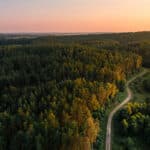Investor Benjamin Graham, an early teacher to Warren Buffett, introduced the concept of Mr. Market in his 1949 book The Intelligent Investor. Mr. Market represents the emotional and schizophrenic nature of stock prices while serving as a foil to rational investors. And who are rational investors? You and me, of course: Spock-like analysts with ice water in our veins, immune to stock tips from our dentist and brother-in-law and born to thrive on Shark Tank.
Well, let’s agree that we at least aspire to make rational decisions. And in doing our day-to-day work to support investment decisions, we all want to be as clean and clear in our thinking as possible. In forestry, the investment options and opportunities associated with carbon, with all of their variability and potential, test our spreadsheet skills.
Carbon Market Economics
Carbon markets operate with certain economic assumptions. Key ones include:
- Raising the price of something (e.g. carbon) will reduce its use.
- It does not matter where (on the planet) a unit of carbon is reduced.
As a starting point, these assumptions work because carbon has value. Forests provide one way to access and capture this value. According to The World Bank’s “State and Trend of Carbon Pricing 2020”, forestry projects accounted for 42% of the credits issued from 2015 through 2019. Growth in forest carbon crediting activities matches increased interest in “nature-based solutions” for mitigating climate change.
Carbon Market Challenges
However, as noted in our first post Forest Carbon Markets Continue to Develop, forest carbon projects have their critics and challenges. To succeed, forest carbon markets and projects must:
- Be able to account for local or regional differences in forests and management;
- Minimize compliance and transaction costs, especially for smaller landowners;
- Include rigorous measurement and verification; and
- Account for leakage where, in short, operators move activities from one market to another to account for carbon offset projects.
Even Mr. Market would see that, while advancing, this sector remains in progress.
This content may not be used or reproduced in any manner whatsoever, in part or in whole, without written permission of LANDTHINK. Use of this content without permission is a violation of federal copyright law. The articles, posts, comments, opinions and information provided by LANDTHINK are for informational and research purposes only and DOES NOT substitute or coincide with the advice of an attorney, accountant, real estate broker or any other licensed real estate professional. LANDTHINK strongly advises visitors and readers to seek their own professional guidance and advice related to buying, investing in or selling real estate.










This is a pretty interesting article about the ins and outs of forestry and carbon and how one impacts the other